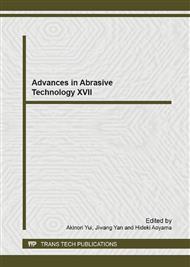[1]
S. Jahanmir, L.K. Ives, A.W. Ruff and M.B. Peterson, Ceramic Machining: Assessment of Current Practice and Research Needs in the United States, NIST Special Publication, Vol. 834, p.102, (1992).
DOI: 10.6028/nist.sp.834
Google Scholar
[2]
H.G. Wobker and H.K. Tonshoff, High Efficiency Grinding of Structural Ceramics, International Conference on Machining of Advanced Materials, NIST Special Publication 847, Gaithersburg, MD, 455-463, (1993).
Google Scholar
[3]
Tanikella, B.V., Somasekhar, A.H., Sowers, A.T., et al., Phase Transformations during Microcutting Tests on Silicon, Appl. Phys. Lett., vol. 69, no. 19, p.2870–2872, (1996).
DOI: 10.1063/1.117346
Google Scholar
[4]
Jasinevicius, R.G., Porto, A.J.V., Duduch, J.G., et al., Multiple Phase Silicon in Submicrometer Chips Removed by Diamond Turning, J. Braz. Soc. Mech. Sci. & Eng., XXVII, no. 4, p.440–448, (2005).
DOI: 10.1590/s1678-58782005000400013
Google Scholar
[5]
Gogotsi, Y., Zhou, G.H., Ku, S.S., et al., Raman Microspectroscopy Analysis of PressureInduced Metallization in Scratching of Silicon, Semiconductor Science and Technology, vol. 16, no. 5, p.345–352, (2001).
DOI: 10.1088/0268-1242/16/5/311
Google Scholar
[6]
Zhou, M., Ngoi, B.K.A., Zhong, Z.W., and Chin, C.S., Brittle–Ductile Transition in Diamond Cutting of Silicon Single Crystals, Materials and Manufacturing Processes, vol. 16, no. 4, p.447–460, (2001).
DOI: 10.1081/amp-100108519
Google Scholar
[7]
J.A. Patten, J. Jacob, B. Bhattacharya and A. Grevstad, Comparison Between Numerical Simulations and Experiments for Single Point Diamond Turning of Silicon Carbide, Transactions NAMRI/SME, Volume 35, pp.89-96, (2007).
DOI: 10.1016/j.jmapro.2008.08.001
Google Scholar
[8]
L. Dong In-situ Detection and Heating of High Pressure Metallic Phase of Silicon during Scratching, PhD Dissertation, University of North Carolina at Charlotte, (2006).
Google Scholar
[9]
Wu, H. and Melkote, S.N., Study of DuctiletoBrittle Transition in Single Grit Diamond Scribing of Silicon: Application to Wire Sawing of Silicon Wafers, J. Engineering Mater. and Technology, vol. 134, no. 4, art. 041011, (2012).
DOI: 10.1115/1.4006177
Google Scholar
[10]
A.R. Shayan., H.B. Poyraz, D. Ravindra, M. Ghantasala and J.A. Patten, Force analysis, mechanical energy and laser heating evaluation of scratch tests on silicon carbide (4H-SiC) in micro-laser assisted machining (μ-LAM) process, Proceedings of the ASME International Manufacturing Science and Engineering Conference, Paper# 84207 (2009).
DOI: 10.1115/msec2009-84207
Google Scholar
[11]
Shayan, A.R., Poyraz, H. B., Ravindra, D. and Patten, J.A., Pressure and Temperature Effects in Micro-Laser Assisted Machining (μ-LAM) of Silicon Carbide, Transactions NAMRI/SME, v. 37, pp.75-80, (2009).
DOI: 10.1115/msec2009-84207
Google Scholar
[12]
F. Z. Fang, X. D. Liu, L. C. Lee, Micro-machining of optical glasses- A review of diamond cutting glasses, Indian Academy of Sciences, Vol. 28, Part 5, (2003).
DOI: 10.1007/bf02703324
Google Scholar
[13]
Blake and Scattergood, 1990, Ductile-regime Machining of Germanium and Silicon, American Ceramic Society, Journal of the America Ceramic Society, Vol 73, Issue 4, pp.949-957.
DOI: 10.1111/j.1151-2916.1990.tb05142.x
Google Scholar
[14]
Coe, S. E., and R. S. Sussmann. Optical, thermal and mechanical properties of CVD diamond., Diamond and Related Materials 9, no. 9 (2000): 1726-1729.
DOI: 10.1016/s0925-9635(00)00298-3
Google Scholar


